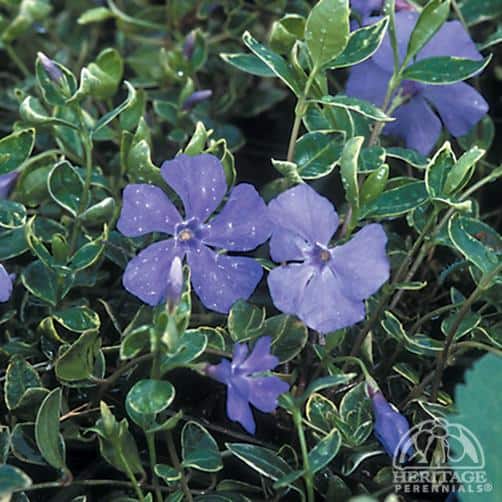
There are good reasons to grow and enjoy periwinkle (Vinca minor, Zone 4). It has a beautiful blue or white spring flower, and small leaves that work well with perennial plants and woody shrubs. Periwinkle, sometimes called myrtle, is a broadleaf evergreen that keeps its glossy leaves in winter. It’s fast growing, making a six-inch (15-cm) thick weed-suppressing mat, rooting from junctures in its long tendrils as they spread along the ground.
Let me be quick to say I’m growing periwinkle in a bed surrounded by lawn on one side and a stone path on the other. It can’t escape and go virile in the landscape, nor end up as a nuisance weed for my neighbours. Because it grows so easily and makes a dense mat, care should be taken not to plant it near woodlands or natural landscapes. A responsible gardener won’t permit periwinkle to become invasive where it’s not wanted.
Periwinkle grows in full or part shade, but more sun doesn’t seem to hinder its growth. I’ve never had to provide any maintenance beyond regular irrigation for periwinkle growing in light shade, but after removing a large beech tree in the front garden, the periwinkle underneath now has a full day of sun and lots more vigor. It suppressed the weeds— particularly thistles—but some perennials, such as two clumps of perennial peas, weren’t able to fight their way through the dense mat of stems and leaves.
Controlling the periwinkle has now become a fall task I tackle every second or third year. I start at one side of the bed, cutting the largest clumps back close to the crowns. Long tendrils that have set down delicate shallow roots can easily be ripped out. I’m not too thorough about the task, removing about three-quarters of the stems and leaves, but it seems to give the other perennials a fighting chance for a couple of years. This thinning out takes about an afternoon, and sets the stage for fresh new foliage and flowers in spring. I’ve read suggestions to low mow periwinkle every couple of years to control growth and renew the foliage, but that seems like certain strangulation for any mower I own.
I could replace the standard green periwinkle with a less vigorous named cultivar such as ‘Ralph Shugert’ (V. minor ‘Ralph Shugert’, Zone 4), which as white-edged leaves; it grows at a slower pace than its cousin. Or I could plant ‘Double Bowles’ (V. minor ‘Double Bowles’, Zone 4), with double blue rosettes, and also less vigorous growth. But why not go for a bolder choice, like ‘Illumination’ (V. minor ‘Illumination’, Zone 4), with blue flowers and golden yellow leaves, each edged with dark green? A wide patch of bright ‘Illumination’ periwinkle would be like having 100- watt light bulbs in the garden bed. These named periwinkles are interesting and attractive plants, and won’t escape to become a rampant nuisance. Well, it’s something to think about. But for now, I’m going to thin and cut back the current periwinkle and be grateful the thistles have been thwarted.
You may also be interested in:

I purchased some annual variegated vinca for my pots, since I love the trailing nature of this plant. Well, it rooted in the middle of my euonymus bush which is also variegated and has happily returned every year for the past 4 years, it is currently (in the fall) blooming! These plants are welcome at my house because they fill many hard to grow places under trees and keep it looking good, without having to trim grass or take out dead plants from under the trees.